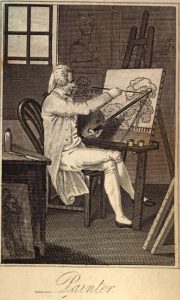
Artists, Musicians, Photographers and Scientists
William Etty 1787-1849
William Etty: The Life and Art By Leonard Robinson
William Etty – Art and Controversy
William Etty by John Watkins, after Unknown photographer
albumen carte-de-visite, circa 1860s In the NPG
His mother married a miller 11 years older than herself when she was 17. Her brother, head of the family, opposed the match, so after 6 years of moving about theysettled in York. William was born on 10thMarch at No 20 Feasegate. He later had a house on Church Yard off Coney St. He was 7thout of 10 children; 5 died in infancy and he had smallpox, which scarred him for life. He did not marry but wanted to He had akettle for a wife: -“It sings sweetly and gives me warmth when I come in”. He was slovenly, short and awkward with a large head, hands and feet, and long wild sandy hair. He was described as ‘One of the oddest looking creatures’. He was in love when he made an ascent of Vesuvius and he described his heart as a ‘Volcano of itself’. He struggled with uncertainty, and agonized waiting for letters to arrive. He eventually found
2satisfaction in his art and excelled in painting voluptuous nudes of both sexes, many of which are in York Art Gallery. He wrote, “For 6 months past I have scarcely known Happiness but by name, and even now I could exchange life with a dog. I have only found existence tolerable by applying vigorously to my Art”. He travelled widely in Europe and met Delacroix. His work was much admired, and in 1828 he defeated Constable in the elections to the Royal Academy. He campaigned to save the Walls from demolition in the 1830’s and in 1910 his statue was erected, with a little model of Bootham Barhalf covered by a drape at his feet. He is buried in St Olave’s churchyard, though his tomb is visible from St Mary’s Ab
voluptatibus commodi numquam, error, est. Ea, consequatur.
William Pumphrey 1817-1905
(1817 – 1905)[1] was an early photographer based in York.
Portrait of William Pumphrey by John Ward Knowles in York Art Gallery
Pumphrey was a Quaker and started out as a science teacher at Bootham School,[2] York. , in July 1849,
The new art of photography intrigued him so much that he bought his licence from Samuel Walker, York’s first practising photographer in July 1849 establishing his Photographic Portrait Gallery, York’s first such business. Pumphrey found the daguerreotype process that he employed for portraiture too limiting and in 1852 began using calotype. The following year he published Photographic Views of York and Its Environs, marking the start of an extensive documentation project. Probably for financial reasons, Pumphrey sold his studio in 1854 to become the director of a lunatic asylum. He continued to lecture on science. On November 7, 1854, the Yorkshire Gazette observed (as an author noted in 1986), “Mr. Pumphrey . . . entered at some length into the origin and progress of the art during the last 30 years and discussed the merits and demerits of the several processes, the daguerreotype and the calotype. He illustrated his remarks with some interesting experiments and a large collection of very beautiful photographic pictures.” Pumphrey showed collodion work in the 1856 Photographic Society exhibition in London. It was his only participation in these exhibitions
He was fond of travel, bringing home many photographs of the scenery of Switzerland and elsewhere, which he took pleasure in showing to his friends with the magic lantern.
In 1866 he organised an exhibition of Yorkshire Fine Art and Industry, in the grounds of Bootham Park Hospital, in which he entered two revolving stereoscopes, each containing 50 of his stereo views


Sculptors and Statuary
C & J Waudby
sculptors 8 Coney Street